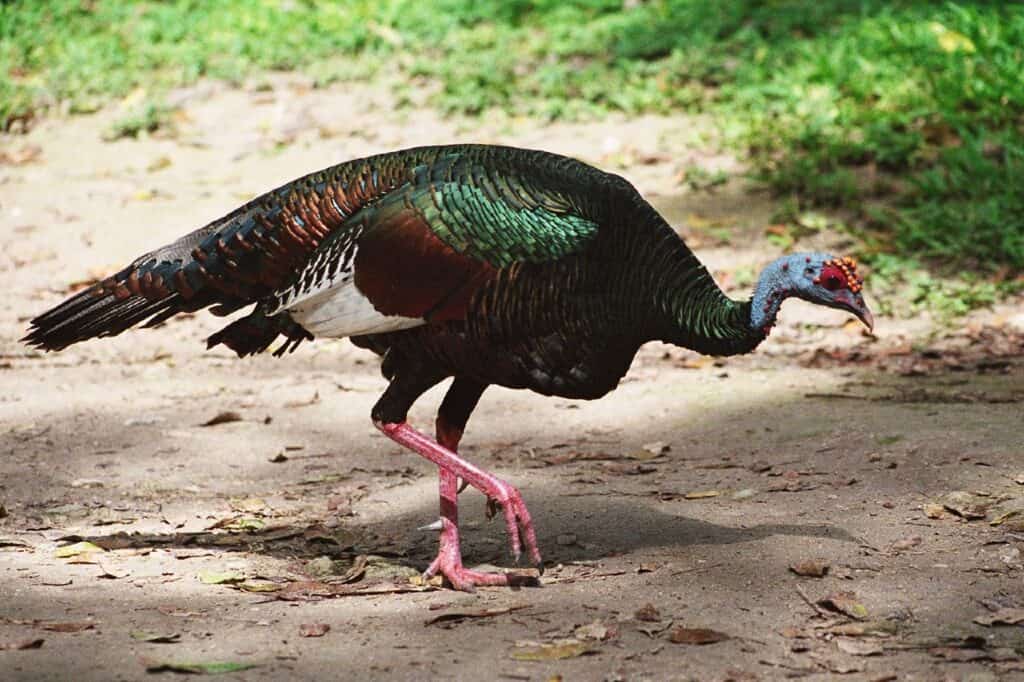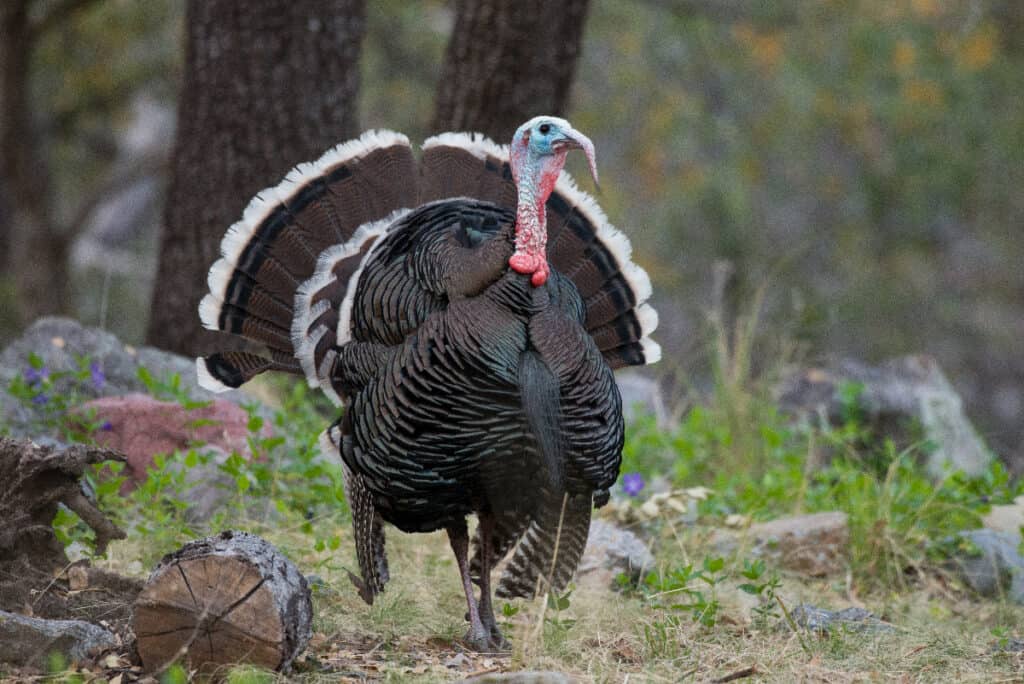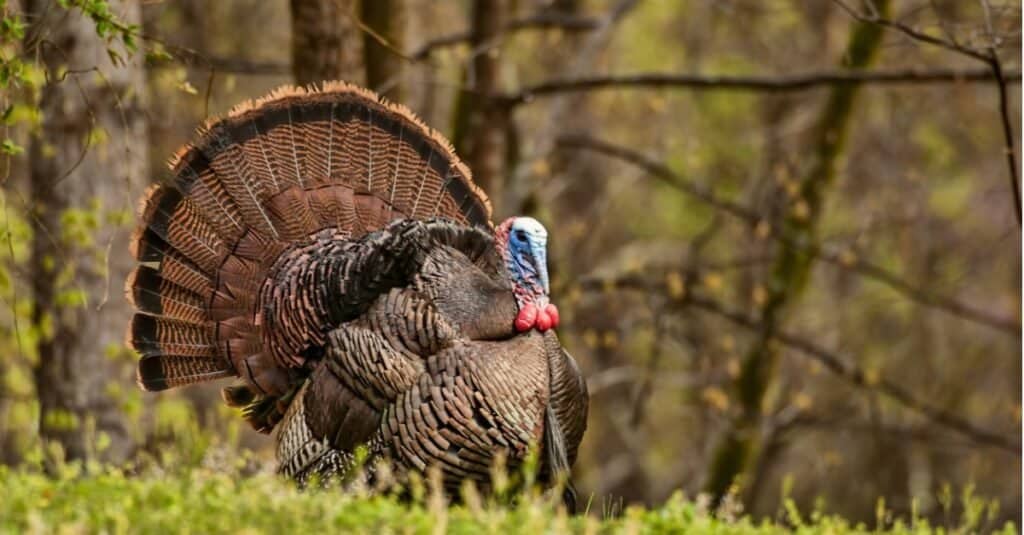Turkeys are large birds in the genus Meleagris. There are two main types of turkeys; the wild turkey and the ocellated turkey. Both of these species have a hanging and wrinkly snood. Interestingly, the turkey got its name because of domestic turkeys imported to Britain from the Levant, specifically the country Turkey.
Interestingly, the wild turkey is an ancestor of the domestic turkey. Turkeys are also not a new species. The earliest turkey is thought to have evolved over 20 million years ago in North America. Male turkeys are larger than female turkeys. There are a few theories on when turkeys were domesticated, but the most recognized is that they were domesticated in Pre-Columbian Mexico. Turkeys were symbolic and important. In some parts of Mexico, residents call turkeys by the Classical Nahuatl word, huehxōlō-to or guajolote in Spanish.
Turkeys are common throughout North America, and they run wild and live in warm and cold climates. When winter comes, so do below-freezing temperatures, sleet, hail, and sometimes snow. So, where do turkeys go in the winter? Keep reading to find out!
Where Do Turkeys Live?

Turkeys prefer forested and woodland habitats.
©Bruno Girin / CC BY-SA 2.0 – License
Turkeys live throughout Southern Canada, Mexico, and the United States. They prefer forested and woodland habitats, however; they adapt well. You can also find the six subspecies of turkeys in swamps and suburban areas. Every subspecies is different, though. For example, Merriam’s wild turkey lives in mountainous regions and prairies. The eastern wild turkey was the first wild turkey European settlers encountered in North America. This turkey has a large range, including the entire eastern half of the United States and some more Western states like Minnesota, Illinois, and Missouri.
The Osceola wild turkey, also known as the Florida wild turkey, is very common in Florida. They have dark feathers with an iridescent green-purple color. They are also the smallest subspecies, typically weighing up to 18 pounds. The South Mexican wild turkey, as the name suggests, is a turkey subspecies only found in Mexico. Sadly, as of 2010, it’s labeled as critically endangered. Gould’s wild turkeys live in the northern mountains of Mexico and the southernmost parts of Arizona and New Mexico. They are the largest of the turkey subspecies. The sixth and final subspecies is the Rio Grande wild turkey. It’s native to the central plain states. This turkey has very long legs and green-coppery and shiny body feathers.
Where Do Turkeys Go in the Winter?
Turkeys, unlike other animals, don’t travel during the winter. They brave out the cold and flock together in large groups for protection. Turkeys sleep in tree branches to avoid the cold snow and ice. They use their wings, which rarely fly, and glide to a branch. Wild turkeys also rarely sleep in the same tree for long. They prefer oaks, cottonwoods, and sycamores. Winter flocks separate by sex and age, but sometimes their “home base” is close together.
Turkeys survive winter with their fat supply. They don’t have thick or warm feathers and instead eat a lot of fat during spring, summer, and fall. During winter, they can lose up to 40% of their body fat before they are at risk for starvation.

Turkey’s thin, ruffled feathers provide them with little help in surviving harsh winter conditions.
Is It Normal to See Turkeys in the Winter?
When cold fronts begin to move into the turkey’s habitat, they will begin to flock into larger groups in order to share resources and retain warmth. Because of this, it is more likely for you to see a big flock of turkeys during the winter as opposed to a few solitary birds. Turkeys do not venture far from their flock during the winter, so turkey hunters will often take advantage of this bird’s peculiar winter habits.
It is due in part to the turkey’s abundance compared with other game birds during the cold season of North America that it became a common fixture of American Winter Holidays like Thanksgiving and Christmas.
Should You Feed Wild Turkeys?

Wild turkeys don’t need additional food in winter, as they have fat storages they rely on.
©Sean R. Stubben/Shutterstock.com
It’s sad to watch a wild turkey walking around in the cold, but they are okay! You should never feed a wild animal seasoned human food. Wild turkeys don’t need additional food in winter; they have fat storages they rely on. It would be a waste of resources. When you feed a wild turkey, they get used to humans. This can teach them they don’t need to hunt, which makes them more susceptible to starvation and predators. It also increases the risk of spreading diseases.
The only time it’s acceptable to feed a wild turkey is when there are 15 or more inches of soft powder snow on the floor for at least 10 days. If you feed them, you can only give them appropriate food like cracked or whole-kernel corn, sunflower seeds, or turkey rations. It’s also important you don’t feed turkeys away from their winter roost sites so they don’t wander away. To help turkeys in the long run, you can also plant oak, beech trees, and wild berries.
What Do Turkeys Eat During Winter?
Turkeys don’t eat a lot during winter. They eat a lot of nuts and berries, including beechnut, acorns, and hickory nuts. Turkeys aren’t picky eaters and change their diets to match the season. For example, in winter, they scavenge for nuts on the ground before heavy snowfall during daylight, but in spring, they eat grass and other plants.
How Long Do Turkeys Live?
If they don’t end up as a Thanksgiving meal, wild turkeys live anywhere from 3-5 years in the wild. Domestic turkeys can live up to 10 years on a farm, although most turkeys raised for food don’t make it to their first birthday.
Turkey eggs usually hatch about a month after being laid. The chicks, or “poults,” will continue to grow outside of their shells, with them becoming young turkeys at about 4 weeks of age. Turkey hens are fully grown at about 14 weeks after hatching, with toms, or male turkeys, taking about 4 weeks longer than their female counterparts to mature.

A turkey has excellent vision, seeing three times more clearly than 20/20.
©iStock.com/Jens_Lambert_Photography
The photo featured at the top of this post is © iStock.com/Robert Winkler
Sources
- Department of Natural Resources, Available here: https://dnr.wi.gov/topic/hunt/documents/turkfeed.pdf
- New Hampshire Fish and Game Department, Available here: https://www.wildlife.state.nh.us/wildlife/turkeys/feed-guidelines.html
Thank you for reading! Have some feedback for us? Contact the AZ Animals editorial team.






